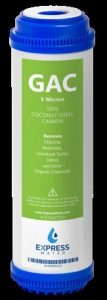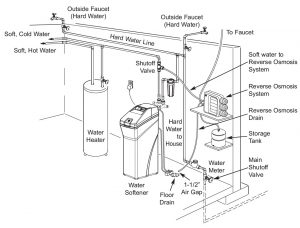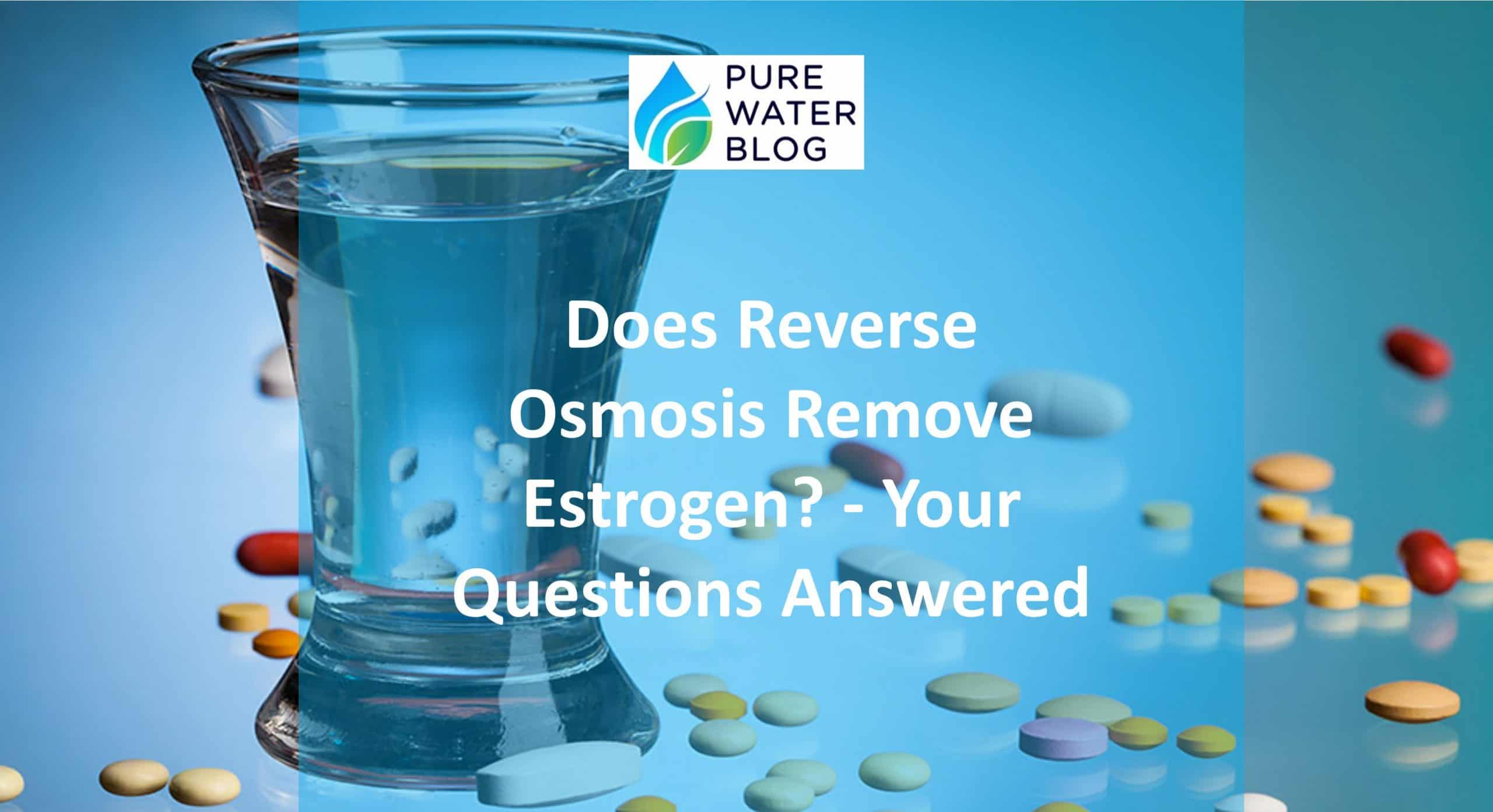You may have heard that reverse osmosis can remove estrogen from water. This is a common concern for homeowners, as they want to make sure their drinking water is safe and free of harmful chemicals.
Reverse osmosis is very effective at removing estrogen from your tap water. The EPA lists reverse osmosis as a benchmark technology for treating estrogen and other hormones. RO systems can remove between 88% to as much as 99% of the estrogen in drinking water. Reverse osmosis systems must be properly maintained to ensure maximum removal efficiency of estrogen.
In this blog post, we answer the question – does reverse osmosis remove estrogen? We also provide information on how reverse osmosis works and what you can do to ensure your water is safe for consumption.
Table of Contents
About Estrogen
Estrogen in drinking water has become a big concern recently. It has been found in about 80% of American rivers and some brands of bottled water.
What is estrogen
The major types of estrogen found in our water supply come from medications like the oral contraceptive pill. The hormones most commonly found in drinking water include:
- estrone
- estradiol
- estriol
- ethinylestradiol
- progesterone
- dexamethasone
- cortisol
There are also synthetic chemicals that can have an estrogenic effect on our bodies. These include:
- bisphenol A
- dihydrofolliculin
- octylphenol
- polyethoxylates
- trihalomethanes
How does estrogen get in my water?
Artificial contraception and hormone replacement therapy are the primary source of estrogen in our drinking water. These drugs are excreted via urine where they are discharged to wastewater treatment plants.
Sewage treatment plants cannot treat estrogen or other hormones, so they are discharged to rivers and other water bodies. These drugs eventually make their way into our drinking water. The Associated Press found dozens of pharmaceutical drugs in the drinking water of 46 million American.
Other sources of estrogen pollution in our drinking water include:
- livestock and poultry fed growth hormones
- plastics that contain BPA
- artificial scents
- detergents and cosmetics that contain parabens
Health concerns with estrogen
Estrogen and other hormone drugs can have serious health effects. They can disrupt the endocrine system and cause developmental problems in children. With hormones, even small amounts can have an impact on the body.
Exposure to high levels of estrogen has been linked to:
- breast cancer
- uterine cancer
- prostate cancer
- infertility
- miscarriage
- low birth weight babies
Chronic exposure to estrogen can affect the sexual development of pre-pubescent teenagers. These groups of children need a great deal of female and male hormones to develop the appropriate sexual characteristics at the proper time.
Men who consume water contaminated with estrogen can develop more breast tissue compared to men of a comparable age. It can also lead to abnormal development and functioning of the prostate.
Drinking water standard for estrogen
The EPA has not established a maximum contaminant level (MCL) for any of the hormones found in drinking water.
The EPA’s Office of Water has developed a draft guidance for regulating estrogen in drinking water. The guidance is currently under review by the EPA’s Science Advisory Board.
Reverse Osmosis
Reverse osmosis is a widely used treatment method that reliably removes a wide range of contaminants from drinking water. It is effective at reducing the concentration of many impurities such as lead, PFAS, and heavy metals.
How RO works
Reverse osmosis systems use a semipermeable membrane to filter impurities from water. The membrane allows water to flow through while trapping dissolved solids and other contaminants. The system applies pressure to the water, forcing it through the membrane and removing any impurities.
The membrane is constructed of a semi-permeable polymer that is spirally wrapped around a central tube. The water is forced through the membrane, and the impurities are filtered out. The clean water is then collected on the other side of the membrane, while the contaminants are retained in a concentrated brine. This brine waste is then flushed down the drain.
Reverse osmosis systems can be used to treat both municipal water supplies and private wells. This treatment technology is effective at removing a wide range of contaminants, including salt, bacteria, viruses, pesticides, and more.
RO system components
Reverse osmosis systems typically consist of three modules:
1. pretreatment
2. reverse osmosis membrane
3. post-filter
 Pretreatment protects the membrane from fouling and damage caused by chlorine. It usually consists of a sediment filter and an activated carbon filter. The sediment filter removes particles such as dirt and rust, while the activated carbon filter removes chlorine and other chemicals.
Pretreatment protects the membrane from fouling and damage caused by chlorine. It usually consists of a sediment filter and an activated carbon filter. The sediment filter removes particles such as dirt and rust, while the activated carbon filter removes chlorine and other chemicals.
The reverse osmosis membrane is the heart of the system. It’s a thin film composite (TFC) that remove contaminants from water. The TFC is made of several layers of material, including a semi-permeable membrane.
The post-filter is the final stage of filtration that removes any remaining impurities from the water. This is typically a second carbon filter that ensures the water is safe to drink and tastes great. It also includes a particle filter to remove any remaining turbidity.
Some RO systems include a water storage tank, which stores the clean water until you’re ready to use it. This is desirable because the flow rate through the filter is slow. Having a storage tank ensures you can fill a glass or a cooking pot quickly with clean water without having to wait.
How Well Does Reverse Osmosis Treat Estrogen
Reverse osmosis can remove estrogen and other hormones from water. Several studies have quantified the removal efficiency of these substances.
Studies and real-world operating data have documented that reverse osmosis can remove as much as 99% of estrogen and other synthetic hormones from water. A study published in International Journal of Science and Research found that RO removed estrogens to >95%.
The RO membrane material effects the overall removal efficiency of estrogen with reverse osmosis. Membranes made from polyethersulphone perform better than conventional materials such as polyethylene.
Factors to Consider with Reverse Osmosis
If you’re concerned about the quality of your drinking water, a reverse osmosis filter may be a good option for you. RO filters are able to remove a variety of contaminants from your water, including lead, mercury, and chlorine. However, there are a few factors you should consider.
Installation cost of reverse osmosis
Depending on your home’s plumbing, installing an RO system can be relatively simple or quite complex. If your home has a standard under-sink configuration, you can likely install the filter yourself. However, if your home has multiple faucets or you need to drill new holes for the filter, it’s best to hire a professional.
A whole-house RO system can be expensive to install, especially if you have to modify your home’s plumbing. An under-sink unit, on the other hand, can often be installed by a good do-it-yourselfer for a reasonable cost. Each home is unique, so you’ll have to determine which system is right for you.
Maintenance cost
RO filters have sediment filters and activated carbon filters that have to be replaced. A sediment filter will usually last for about six months before it needs to be replaced. Carbon filters have to be replaced every 3 to 6 months, depending on how much water you use and the amount of chlorine in your water.
The cost of replacement filters can vary, but you can expect to spend around $60 to as much as $200 per year on them. Whole house filters are 3 to 4 times as much as under-sink filters.
While this may seem like a lot, it’s important to remember that RO filters can remove a variety of contaminants from your water, making it safer and healthier to drink.
Whole-house versus under-sink units
Another thing to consider is how much water you’ll need to filter. RO filters are typically sized according to the number of gallons they can process per day. If you have a large family or use a lot of water for cooking and bathing, you may need a larger filter.
Reverse osmosis systems are available in a wide range of sizes, from small countertop units to large industrial systems. They can be used for point-of-use (POU) applications, such as filtering water for a kitchen sink, or point-of-entry (POE) applications, such as filtering all the water coming into your home.
Deciding which type of RO system is right for you depends on a number of factors, including your budget, the size of your home, and your water quality. Read my article on under-sink RO systems and whole-house RO systems for a detailed explanation.
NSF certification
Reverse osmosis filter manufacturers often make claims about how well their units remove contaminants. The best way to be certain of their claims is to look for units that have been certified by NSF International.
NSF is an independent organization that tests and certifies products to ensure they meet strict standards for quality and safety. If a product has been certified by NSF, you can be confident it will perform as advertised.
The applicable standard for point-of-use reverse osmosis systems is NSF/ANSI 58. It covers the following parameters:
- Materials of construction and leaching of harmful substances
- Mechanical integrity
- Removal of total dissolved solids (TDS)
- Efficiency rating
- Recovery rating
- Contaminant concentration reduction
Treatment Methods that Remove Estrogen
Several other treatment systems can remove estrogen and hormones from drinking water.
1 – Activated carbon filters
Carbon filtration can reduce the concentration of estrogen in drinking water. Carbon works by adsorbing the estrogen onto the surface of the filter media.
Granular activated carbon (GAC) filters are commonly used to treat drinking water. GAC filters can remove up to 85% of certain synthetic estrogens.
Advantages:
- relatively low cost
- no electricity required
- can be used for either whole-house or point-of-use treatment
Disadvantages:
- requires regular replacement of filter cartridges
- reduces water pressure
2 – Black Berkey filters
The Black Berkey purification elements have been successfully tested for reduction of several endocrine-disruptors, including:
- BPA
- Nonylphenol
- Octylphenol
- Progesterone
- THMs
3 – Distillation
Distillation is effective at removing estrogen and other hormones from drinking water. Distillation systems work by boiling water and collecting the resulting steam. The steam is condensed and collected as distilled water.
FAQs
Does boiling water remove estrogen?
Boiling water does not remove estrogen or any other hormones from drinking water. One problem with boiling water is that it can concentrated the contaminants.
Does a water softener remove estrogen
Water softeners do not remove estrogen from water. Water softeners work by exchanging magnesium and calcium ions for sodium ions. This process does not remove estrogen or other hormones from the water.
Conclusion
So, does reverse osmosis remove estrogen? The answer is a resounding yes. Reverse osmosis systems are able to remove 90% to more than 99% of estrogen from water.
However, there are some factors you’ll want to consider before purchasing a system for your home. Installation and maintenance costs can vary greatly, so it’s important to do your research and find the best system for your needs.

